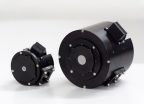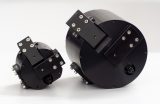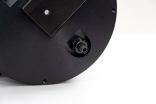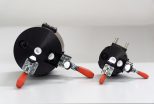MountainSphere
If you want to measure not only the total transmission through a sample or reflection on a sample, but also directional and diffuse parts as well as haze values separately and at different angles of incidence, we recommend the MountainSphere.
The MountainSphere measurement system was specially designed as a response to multiple customer requests, and can be customized as desired.
The modular design consists of a closed integrating sphere with a top round entry port. The light collected in the sphere can be led out via an SMA connector.
MountainSphere-Irradiance
MountainSphere-Irradiance is the basic version and particularly well suited for irradiance measurements, as the incident light can be measured homogeneously and independently of angle. In addition, transmission measurements can be done with MountainSphere-Irradiance. For this purpose, the integrating sphere can be mounted on the optionally available MountainSphere-Stand, whose built-in collimating lenses generate a collimated beam into the port of the sphere at angles of incidence of 0° or 20°. The collimating lens is thereby connected to an external light source via an optical fiber with SMA connector.
MountainSphere-Reflection
For reflection measurements on surfaces or samples, a collimating lens can be integrated into the MountainSphere, which uses a fiber-coupled light source to generate a collimated beam inside the sphere that illuminates the sample from the inside of the sphere so that the reflected light is completely captured by the sphere. This MountainSphere-Reflection can also be mounted to the optional MountainSphere-Stand for convenient sample support.
MountainSphere-Haze
Finally, the maximum configuration level of the MountainSphere is the MountainSphere-Haze. In addition to the MountainSphere-Reflection, it has two opening output ports at 0° and 20° opposite the input port. In this way, total and diffuse transmission can be measured separately. The measured data can then be used to determine the directional component and the haze value of the transmission. An analogous measurement can also be performed in reflection, again using the collimating lens built into the sphere, which illuminates the sample from the inside of the sphere at an angle of incidence of 20°. By opening or closing the output port, total reflection, diffuse and directional reflection as well as haze value of the reflection can be determined.







